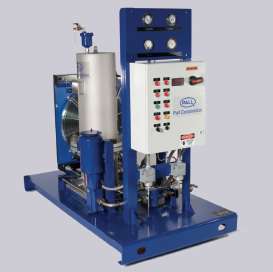Power Company Improves Gas Turbine Reliability by Removing ‘Varnish’
Product: VRFII Varnish Remediation System
Application
A power generation company based in Colorado, USA, operating a GE Frame 7A gas turbine on a simple cycle, experienced a steady increase of varnish levels in the lube oil, coating critical system components, identified during routine monitoring of the turbine lubrication system.
The turbine lubrication system of 6,200 litres capacity using ExxonMobil TerresticTM ISO 32 lube oil had been in service for approximately 48,000 hours over a 7 year period, and protected by 5 µm nominally rated return-line filtration of unknown make
The Varnish Potential Rating or VPR℠ (ie. the potential likelihood of a lubricant's tendency to form varnish deposits) was measured via membrane patch colorimetry method and found to be at a level of 85, indicating a high‐level of insoluble oil degradation products associated with varnish, beyond the operators ‘critical’ limit. Immediate oil treatment was recommended to return the oil to normal recommended operating conditions.
The Pall Solution
A Pall VRF varnish remediation unit was deployed in a kidney loop configuration. The skid uses a cooler to maintain optimum oil temperature for the most efficient varnish removal before passing the oil through a specially designed adsorptive media, optimized for removal of varnish-forming precursors from the oil. At the outlet the oil flows through a Pall SRT technology, antistatic filter, rated at ß12(C) ≥ 1000 for additional protection and improved fluid cleanliness, before returning to the main reservoir.
Result
An immediate improvement in VPR℠ was seen, falling from 85 to 38 (within normal recommended limits) in less than one week. At a flow of 11 GPM multiple passes of the system fluid through the VRF unit over a period of a further 4 weeks returned the fluid to a VPR of 11 with negligible signs of varnish on test membranes taken during treatment.
The soft varnish coating on components and flow paths was also entrained back into the fluid and removed. Tests conducted to assess the effect on the fluid additives after VRF treatment indicated no change of additive content between the unfiltered fluid and fluid that was filtered >20 times, suggesting that the VRF medium had no noticeable adverse effect on the fluid.
Since one of the known contributors towards the formation of varnish is the electrostatic discharge induced by oil filters, it was also recommended that the plant utilize anti-static media with the AN grade (Beta 7(c) = 1000) Pall SRT technology that uses electrostatic charge dissipating filtration media.
For more information on removing the threat of varnish from your turbine lube system before it causes system downtime, contact us at Pall.





